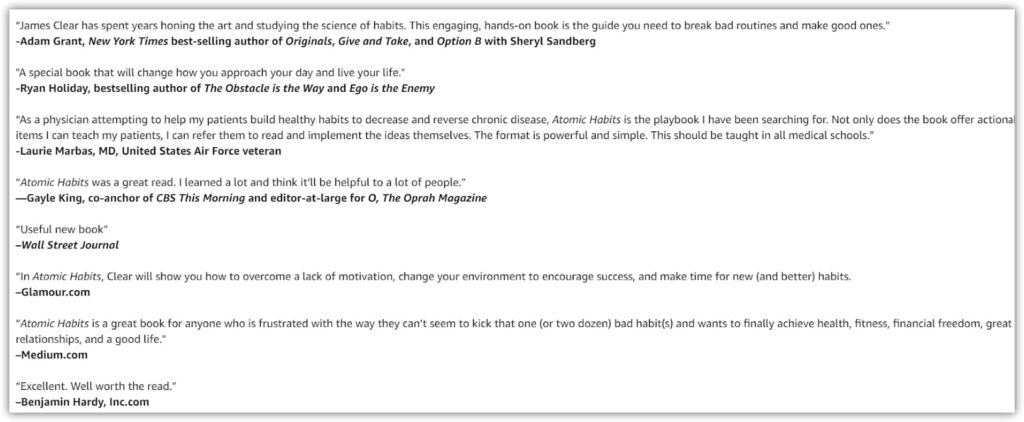Have you ever bought a product or subscribed to a service after seeing a famous person talk about it? Well, this is the power of endorsement from authority figures. Authors have been using this power to market their books in a subtle but effective way in what is known as editorial reviews. Not only do these reviews add credibility to their work, but they also attract potential readers who trust the opinions of these respected voices.
To better understand what editorial reviews are all about, we’ll explore their importance, how to get them, and how to use them to elevate your book’s visibility and sales.

What Is an Editorial Review?
Generally speaking, an editorial review is an expert’s evaluation of a written piece (a book or an article). This evaluation tends to be objective, adding credibility to the author’s work.
When it comes to books, these reviews act as endorsements of this particular book, and they are written by an industry expert or known figures. These could be celebrity figures, famous authors, or big media outlets (such as The Guardian or the New York Times). The reviews are usually written before the book’s publication and are used to market it to potential readers and bookstore owners.
Here is an editorial review example of the best-selling book, Atomic Habits:

Why Editorial Book Reviews Matter
If you are wondering whether you should work on getting editorial book reviews or not, the answer is always yes! Having these reviews can hugely impact the success of your book in so many ways, including:
- Establishing Credibility
Having a subject matter expert write an editorial review on your book can significantly improve its credibility. These reviews, being more objective than reader reviews, offer endorsements that resonate deeply with readers who value authoritative opinions.
- Boosting Book Sales
Many bookstores and online book retailers feature books with positive editorial reviews, giving them greater visibility. This enhances your book’s chances of being noticed by your target readers, ultimately boosting its sales.
- Improving Marketing Opportunities
You can use your book’s editorial reviews to market it through different channels. For example, you can use them on your book cover or blurb, share them on social media, or include them in press releases. We’ll discuss this point in more detail later in the article.
Editorial Book Reviews vs Reader Reviews
It is important to differentiate between editorial book reviews and reader (or customer) reviews. While both are important and both act as social proofs, editorial reviews give more credibility to your work. To better understand the difference between these two types of reviews, take a look at the following table:
| Editorial Reviews | Reader Reviews | |
| Source | Professional reviewers and literary critics | Fans and casual readers |
| Place of Publication | Literary magazines, newspapers, and book review websites; often excerpts are included on book covers or front matter | Online book retailers (such as Amazon), Goodreads, and personal blogs |
| Tone and Style | Formal, analytical, and well-structured | Informal, personal, and varies in styles |
| Content Focus | An in-depth analysis of the book that includes a critique of the writing style, themes, and literary devices used by the author | Personal enjoyment, emotional response, and plot points |
| Credibility | High credibility, with the professional credentials of the reviewer | Varies widely, depending on the reviewer’s experience and reputation |
| Cost | Can be paid for, but expected to be honest and unbiased | Potential ethical concerns for paid reader reviews |
| Time of Publishing | Often published around the book’s release date or in advance | Can be posted anytime, often after the book’s publication |
| Impact | Significant impact on the book’s literary reputation and potential awards | A strong influence on potential readers’ purchase decisions |
How to Get Editorial Reviews for Your Book: The Easy Way
There are two main ways most self-published and new authors get editorial reviews. The first is by seeking professional editorial review services, whether free or paid. This method has a high probability of securing editorial reviews for your book. And while the paid services might seem more credible than the free ones, remember that credibility isn’t solely determined by the price tag.
Both paid and free websites gain their credibility through a combination of factors, including their reputation, review quality, transparency, and community engagement. Even though the people who write the reviews for these websites might not be well-known public figures or published authors, they are usually selected for their expertise, reputation, and strong writing skills. Additionally, they often receive training and feedback for the reviews they write.
1. Paid Editorial Review Websites
As a new author, you might be wondering if it is okay to pay for editorial reviews, and the answer is, yes, it is completely fine. Unlike customer reviews, obtaining paid editorial reviews is quite common and completely ethical.
The first step in getting editorial reviews is setting a budget. How much are you willing to spend to get these reviews? Keep in mind that they can have a good ROI since you’ll be using them in marketing your book.
But how much do paid editorial reviews cost? Well, they usually range from $100 to $600 per review, depending on the service you hire and the word count of the review. For example, take a look at the following services:
- IndieReader: Created by authors for authors, this website offers several useful services, with their basic editorial reviews starting from $200.
- Kirkus Reviews: As a well-known website, Kirkus’s services are slightly more expensive than IndieReader; its editorial reviews start from $399, and go up to $599 per review.
- Self-Publishing Review: This online magazine offers reviews that start from only $99 per book. Their most elaborate review costs $329 and comes with other marketing options (like shares on social media).
- BlueInk Review: This website offers editorial reviews for both traditional and self-published books. Their services start from $445 and go up to $745 for a 2 review package.
- Reedsy Discovery: While you will have to pay only $50 for a review from Reedsy, there is no guarantee that you’ll actually get one. That’s to say that if the reviewers don’t like your manuscript, it’ll be declined and you won’t get your money back. But if you did get a positive review, it can be a good exposure for your book.
- BookLife: If you’d like your book to be featured in Publishers Weekly, then you can pay BookLife $399 to get the job done for you. This review is not only guaranteed, but it is also detailed (about 300 words) and can help you reach the right audience.
- Feathered Quill: Starting at $85 per review, this website offers different packages that come with various promotional options, such as posting the review on Amazon and Barnes and Noble and sharing your book cover on their social media channels.
- Pacific Book Review: Pacific Book Review is a recognizable name in the book world. Their reviews are written by specialists who are selected for their knowledge and expertise in each genre. Starting from $350, their reviews are usually detailed and might be chosen to be featured on their home page.
- The Independent Review of Books: This website is dedicated to reviewing fiction books. Their reviews are usually 500 words long and can cost from €91.89 to €229.73.
- Midwest Book Review: For only $50, this website can provide you with an editorial review for your book. It accepts PDFs, printed books, pre-publication manuscripts, galleys, uncorrected proofs, and ARCs.
2. Free Editorial Reviews Websites
What if you don’t have the budget or feel uneasy about paying for editorial reviews? Then you can try pitching websites that offer free reviews. The only catch is that your book has to stand out for them to review it, and maybe even share their review on their social media accounts. The process for submitting your book to be reviewed differs from one website to the other. While some may require a physical copy, others can review a PDF or even an audio version of your book.
But where can you find these websites? Well, we have compiled a list for you to browse and pick the ones that fit your book:
- TeamGolfwell: A team of retired people in New Zealand came together to offer this service for new authors. Not only do they review books for free, they also post about them on their social media channels.
- Publishers Weekly: This is one of the most prestigious websites to get reviews from, but it can also be quite challenging. These reviews are usually about 200 words long.
- Readers Favorite: Whether or not you’ve published your book, you can submit it to be reviewed by this website. While it has previously reviewed the work of some established authors, such as James Patterson and Stephanie Meyer, its main focus now is on new and indie authors to help them get the recognition they need.
- Library Journal: This website provides reviews for a wide variety of genres, except for textbooks, children’s books, Young Adult books, and very technical or specialized books. It also requires the book to be submitted for review 6 months before its publication.
- Reader Views: This website offers both a “Guaranteed Review Service” for a fee and a standard review service without having to pay anything. However, the standard service depends on the availability and interest of reviewers.

How to Get Editorial Reviews for Your Book: The Hard Way
There is an alternative path for getting editorial reviews, and that’s asking specific individuals to write an editorial review for your book. This method requires putting in a lot of effort, but when it works, it can hugely impact the success of your book and bring a lot of attention to it. Here’s how you can go about it:
1. Collect Names
The first thing you need to do is have a list of all the possible people or organizations that you would like to get an editorial review from. These could be experts in the field of your book, celebrities, or big institutions. If you don’t have any specific person in mind, begin by considering whose endorsement you’d like on your book cover, and then see if you can find their contact information.
You can also look for those who wrote editorial reviews on books similar to yours. Once you have a list of them, do some research to see who these people are and if they work for any particular organization, through which you can contact them.
2. Organize Your List
Now that you have a list of potential reviewers, you can organize them in a spreadsheet. You can add columns for their name, contact information (email or social media accounts), similar books they’ve reviewed before (if any), notes about the status of your communication with them (if they have replied or not, for example), and whether or not you need to follow up with them.
One of the things this list is going to help you with is staying organized while sending batches of emails to these potential reviewers. That’s right; it is better to contact 10 or 20 reviewers at a time, wait for a couple of weeks, then start contacting the next batch.
3. Prepare Email Templates
Having an email template that you can modify and send to the different reviewers on your list can make the process much easier for you. With that said, it’s very important to customize each email to the person you’re sending it to. Emails that aren’t customized are more likely to be ignored or rejected.
Pro Tip: According to the Alliance of Independent Authors, it is better to send your book cover with the phrase “your endorsement here” on it. This allows them to visualize how a quote from their review would appear on your book. Additionally, this can demonstrate your professionalism, making them more likely to review your book.
To make it easier for you, we have prepared an email template that you can download and customize to your needs.
4. Follow Up
Haven’t heard back from those potential reviewers yet? Wait a couple of weeks before you send a follow-up email or message to avoid annoying them. Don’t forget to update your subject line (in case of email) to reflect the content of your email; you can use something along the lines of: “Follow-Up: [Your Book Title] Editorial Review Request”. And avoid being too pushy by using words such as “Urgent” or “Please Reply”.
You also want to keep this follow-up short and sweet. Start with a gentle reminder (“I submitted my manuscript [Title] for review on [Date].”) Then ask for an update (“I was wondering if there’s any update on the review process?”). Finally, don’t forget to sign off gracefully and thank them for their time.
5. Do Not Give Up
No one, no matter who they are, gets positive responses all the time. So don’t expect to have everyone respond to your email right away. This doesn’t mean you should give up either. Keep updating your list and sending your emails until you get the response you’re looking for. And if all else fails, you can always use a paid service to get the reviews you need.

How to Use Editorial Reviews to Market Your Book
Alas! You did manage to get some editorial reviews for your book! Now what can you do with them? Well, it is time to make use of these reviews to market your book. Here are a few examples of where you can place them to attract more readers:
- Book cover: Your book cover is the first place you can use to add the editorial reviews you’ve received. Just add an excerpt of this review on the front and back covers (in the blurb), and let the readers know what experts say about your work.
- Front Matter: Since the “Praise for the Book” page is the very first page of the front matter section, placing the editorial reviews there can capture readers’ attention and make them more interested in purchasing the book.
- Book Trailer: While book trailers are a good marketing tool on their own, using positive editorial reviews in these videos can add credibility and make the viewers eager to know more about your work.
- Book Landing Page: Check the landing page of any bestselling book, and you’ll surely find some editorial reviews endorsing it. Whether this landing page is on your author website or any digital publishing platform (such as Kotobee Books), you should always make use of the editorial reviews by adding them to the book description you have on these pages.
- Social Media: This is one of the most important places to share your editorial reviews. By sharing positive reviews on your social media pages, you can highlight the quality and value of your book. In turn, this can encourage more readers to engage with your work and potentially increase your fan base.
- Newsletter: Last but not least, if you have a mailing list, then you should definitely send these editorial reviews in your newsletters. Since the readers you have on your list already follow your work, they’d be happy to see these expert opinions, which can enhance their trust and interest in your content.

Final Thoughts for Authors
Much like seals of approval, editorial reviews ensure potential readers of your book’s credibility. While the process of getting them can be hard at times, they can hugely impact the success of your book. So get ready to use the tips shared in this article to secure those valuable endorsements and watch your book’s visibility and sales soar.
.
Read More
How to Publish a Book for Free and Maximize Your Profit
The 4 Key Elements of a High-Conversion Book Landing Page
Successful Book Launch Tips and Tricks for First-Time Authors

